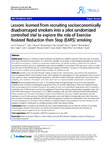Lessons learned from recruiting socioeconomically disadvantaged smokes into a pilot randomized controlled trial to explore the role of Exercise Assisted Reduction then Stop (EARS) smoking.
| dc.contributor.author | Panda, Asim | |
| dc.contributor.author | Greaves, CJ | |
| dc.contributor.author | Ayres, Richard | |
| dc.contributor.author | Aveyard, P | |
| dc.contributor.author | Warren, FC | |
| dc.contributor.author | Byng, Richard | |
| dc.date.accessioned | 2015-11-19T09:02:40Z | |
| dc.date.available | 2015-11-19T09:02:40Z | |
| dc.date.issued | 2015 | |
| dc.identifier.issn | 1745-6215 | |
| dc.identifier.issn | 1745-6215 | |
| dc.identifier.other | 1 | |
| dc.identifier.uri | http://hdl.handle.net/10026.1/3821 | |
| dc.description.abstract |
Background Research is needed on what influences recruitment to smoking reduction trials, and how to increase their reach. The present study aimed to i) assess the feasibility of recruiting a disadvantaged population, ii) examine the effects of recruitment methods on participant characteristics, iii) identify resource requirements for different recruitment methods, and iv) to qualitatively assess the acceptability of recruitment. This was done as part of a pilot two-arm trial of the effectiveness of a novel behavioral support intervention focused on increasing physical activity and reducing smoking, among disadvantaged smokers not wishing to quit. Methods Smokers were recruited through mailed invitations from three primary care practices (62 participants) and one National Health Stop Smoking Service (SSS) database (31 participants). Six other participants were recruited via a variety of other community-based approaches. Data were collected through questionnaires, field notes, work sampling, and databases. Chi-squared and t-tests were used to compare baseline characteristics of participants. Results We randomized between 5.1 and 11.1% of those invited through primary care and SSS, with associated researcher time to recruit one participant varying from 18 to 157 minutes depending on time and intensity invested.Only six participants were recruited through a wide variety of other community-based approaches, with an associated researcher time of 469 minutes to recruit one participant. Targets for recruiting a disadvantaged population were met, with 91% of the sample in social classes C2 to E (NRS social grades, UK), and 41% indicating mental health problems. Those recruited from SSS were more likely to respond to an initial letter, had used cessation aids before, and had attempted to quit in the past year. Overall, initial responders were more likely to be physically active than those who were recruited via follow-up telephone calls. No other demographics or behaviour characteristics were associated with recruitment approach or intensity of effort. Qualitative feedback indicated that participants had been attracted by the prospect of support that focused on smoking reduction rather than abrupt quitting. Conclusions Mailed invitations, and follow-up, from health professionals was an effective method of recruiting disadvantaged smokers into a trial of an exercise intervention to aid smoking reduction. Recruitment via community outreach approaches was largely ineffective. Trial registration ISRCTN identifier: 13837944, registered on 6 July 2010 | |
| dc.format.extent | 1- | |
| dc.format.medium | Electronic | |
| dc.language | English | |
| dc.language.iso | English | |
| dc.publisher | Springer Science and Business Media LLC | |
| dc.subject | Harm reduction | |
| dc.subject | Tobacco control | |
| dc.subject | Physical activity | |
| dc.subject | Recruitment | |
| dc.subject | Smoking cessation | |
| dc.subject | Primary care | |
| dc.subject | Community medicine | |
| dc.title | Lessons learned from recruiting socioeconomically disadvantaged smokes into a pilot randomized controlled trial to explore the role of Exercise Assisted Reduction then Stop (EARS) smoking. | |
| dc.type | journal-article | |
| dc.type | Article | |
| plymouth.author-url | https://www.webofscience.com/api/gateway?GWVersion=2&SrcApp=PARTNER_APP&SrcAuth=LinksAMR&KeyUT=WOS:000413222500001&DestLinkType=FullRecord&DestApp=ALL_WOS&UsrCustomerID=11bb513d99f797142bcfeffcc58ea008 | |
| plymouth.issue | 1 | |
| plymouth.volume | 16 | |
| plymouth.publication-status | Published | |
| plymouth.journal | Trials | |
| dc.identifier.doi | 10.1186/1745-6215-16-1 | |
| plymouth.organisational-group | /Plymouth | |
| plymouth.organisational-group | /Plymouth/Faculty of Health | |
| plymouth.organisational-group | /Plymouth/Faculty of Health/Peninsula Medical School | |
| plymouth.organisational-group | /Plymouth/REF 2021 Researchers by UoA | |
| plymouth.organisational-group | /Plymouth/REF 2021 Researchers by UoA/UoA03 Allied Health Professions, Dentistry, Nursing and Pharmacy | |
| plymouth.organisational-group | /Plymouth/Research Groups | |
| plymouth.organisational-group | /Plymouth/Research Groups/FoH - Community and Primary Care | |
| plymouth.organisational-group | /Plymouth/Research Groups/Institute of Health and Community | |
| plymouth.organisational-group | /Plymouth/Research Groups/Institute of Translational and Stratified Medicine (ITSMED) | |
| plymouth.organisational-group | /Plymouth/Research Groups/Institute of Translational and Stratified Medicine (ITSMED)/CCT&PS | |
| plymouth.organisational-group | /Plymouth/Research Groups/Plymouth Institute of Health and Care Research (PIHR) | |
| plymouth.organisational-group | /Plymouth/Users by role | |
| plymouth.organisational-group | /Plymouth/Users by role/Academics | |
| plymouth.organisational-group | /Plymouth/Users by role/Researchers in ResearchFish submission | |
| dc.publisher.place | England | |
| dcterms.dateAccepted | 2014-11-24 | |
| dc.identifier.eissn | 1745-6215 | |
| dc.rights.embargoperiod | Not known | |
| rioxxterms.versionofrecord | 10.1186/1745-6215-16-1 | |
| rioxxterms.licenseref.uri | http://www.rioxx.net/licenses/all-rights-reserved | |
| rioxxterms.type | Journal Article/Review |


